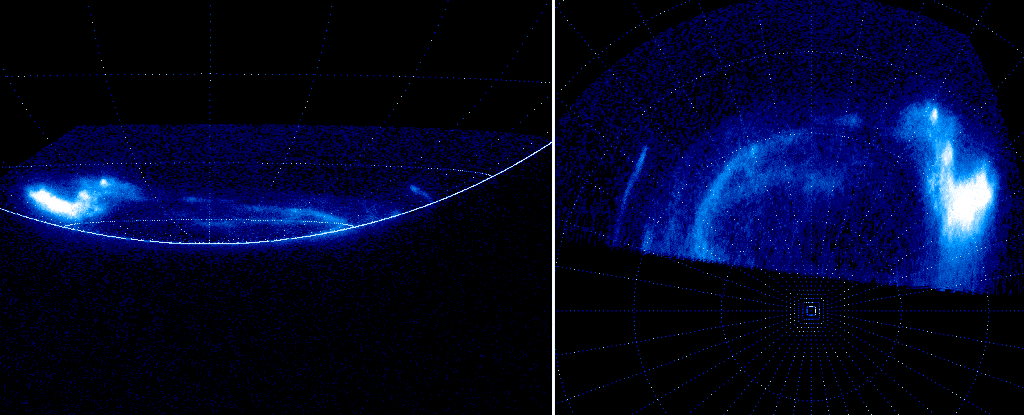Just as the Earth has spectacular auroras, other solar system planets also have their own versions of the atmospheric light show.
In fact, Jupiter has the most powerful auroras in the solar system – invisible to our eyes, but glows brilliantly in ultraviolet wavelengths.
Because Jupiter is so wildly different from Earth, scientists are very interested in learning about these incredible atmospheric phenomena – and they just got a new idea. Thanks to the Juno orbit, we have now for the first time observed the onset of Jupiter’s mysterious auroral dawn storm.
Jupiter’s auroras are produced by a constant rain of high-energy electrons that are mostly stripped from the atmosphere of Io. It is accelerated along magnetic field lines to Jupiter’s poles, where it falls into the upper atmosphere and interacts with the gases to produce a glow.
It is different from the auroras of the earth, which are produced by particles of the solar wind. Unlike Earth’s auroras, Jupiter’s auroras are permanent and can behave completely differently.
One of these behaviors is the dawn storm – an intense brightening and widening of the aurora at dawn, first observed in 1994. However, these dawn storms start on the night side of the pole, and we could never see them form. until NASA’s Juno probe arrived on the scene.
“By observing Jupiter’s aurora from Earth, you can see no further than the limb in the night side of Jupiter’s poles,” explained astronomer Bertrand Bonfond of the University of Liege in Belgium.
“Exploration by other spacecraft – Voyager, Galileo, Cassini – took place from relatively great distances and did not fly over the poles, so they could not see the full picture. Therefore, the Juno data is a real game changer, which we” a better understanding of what happens at night, where the dawn storms are born. ‘
 The rise of a dawn storm. (NASA / JPL-Caltech / SwRI / UVS / ULiège / Bonfond)
The rise of a dawn storm. (NASA / JPL-Caltech / SwRI / UVS / ULiège / Bonfond)
Dawn storms are really something. They start on the night side of the planet, turning in the eye as dawn breaks, transforming Jupiter’s aurora into a burning ultraviolet beacon and emitting hundreds to thousands of gigawatts of light – at least ten times more energy than the ordinary Jovian aurora. They continue for a few hours before sinking to a more normal energy level.
Because the two planets have such differences between their auroras, the process that generates the dawn storm would not be expected to be different from any processes seen in the auras of the earth. Surprisingly, however, the data from Juno’s ultraviolet spectrograph seemed strangely familiar.
“When we looked at the entire dawn storm sequence, we could not help but notice that the dawn storm walls at Jupiter are very similar to a kind of terrestrial auroras called substorms,” said astronomer Zhonghua Yao of the University of Liège.
The auroral storms of the earth are incredible to see. It occurs when the earth’s magnetosphere is disturbed by electric currents, leading to an explosive release of energy into the ionosphere. The energy disappears as a complex, dancing aurora that can last for several hours.
Substorms are strongly influenced by the solar wind and the orientation of the interplanetary magnetic field. But the earth’s magnetosphere is dominated by interaction with the solar wind; Jupiter’s are filled with plasma stripped of Io, which is controlled by the location of the planet.
According to the team’s analysis, Jupiter’s auroral dawn storms are affected by too much plasma from Io, rather than the solar wind; but the result is the same, a disturbance of the magnetosphere leading to an explosive release of energy.
In both cases, the build-up of plasma and energy gradually increases the instability in the system to a heyday.
It can increase our understanding of the auroral processes on both planets, and can help us better understand the aurora on other bodies in the future – including brown dwarfs, who have strong enough auroras to detect in interstellar space, even if they are not near a star.
“Although the ‘engine’ of the auroras on Earth and Jupiter is very different, it shows for the first time that the links between the two systems can identify universal phenomena and distinguish them from the details in relation to each planet,” Yao said. .
“The magnetospheres of Earth and Jupiter store energy through many different mechanisms, but when this accumulation reaches a breaking point, the two systems release this energy explosively in a surprisingly similar way.”
The research was published in AGU advances.
